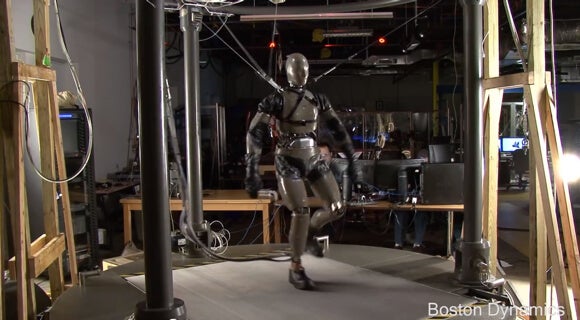Google Buys Boston Dynamics in Sensational Eighth Robotics Acquisition
Google just acquired Boston Dynamics. It’s the eighth robotics company the California tech titan has purchased in six months and, by far, the biggest deal. For two decades, Boston Dynamics has been nearly synonymous with robotics.

Share
Google just acquired Boston Dynamics. It’s the eighth robotics company the California tech titan has purchased in six months and, by far, the most significant. For two decades, Boston Dynamics has produced some of the world's most advanced robots.
Neil Jacobstein, co-chair of the Artificial Intelligence and Robotics Track at Singularity University, told Singularity Hub, “This is a watershed event. A very big deal. Google is buying up high potential robotics companies. Boston Dynamics is the pick of the litter.”
Even if you don’t follow technology or robots closely, you may have watched one of their viral videos with some combination of awe, fear, and the realization that robots are nowhere near as clunky as you thought they were.
The firm’s humanoid Atlas and Petman robots can balance on two legs, walk, and do calisthenics. Video of an uncannily human Petman in fatigues—the robot was built to test chemical warfare gear—drew over three million views earlier this year.
Beyond the bipedal, the company’s Cheetah robot runs faster than Usain Bolt; their WildCat robot recently took Cheetah's tricks beyond the treadmill; their robot SandFlea leaps onto tall buildings; and LS3 autonomously follows soldiers across rough terrain, carrying gear and supplies on its back. (Check out the full roster here.)
The Boston Dynamics bots are rugged and multi-functional. And while many robotics firms are doing inspiring work, none have produced a complete package that so closely resembles the popular image of what a robot should be.
Google, meanwhile, has billions at its beck and call. They make clever algorithms with designs on artificial intelligence, own the most sophisticated self-driving car on the road, and write paychecks to AI luminaries like Geoffrey Hinton and Ray Kurzweil.
It’s simple addition to see why the deal is making headlines.
Some folks look on some of Boston Dynamics’ creations with trepidation because they have largely been funded by the Defense Advanced Research Projects Agency (Darpa). But Boston Dynamics founder, Marc Raibert, has said he doesn’t consider his firm to be part of the military industrial complex. They’re just trying to take robotics to the next level.
Meanwhile, Darpa says Boston Dynamics robots will find useful, innocuous applications helping soldiers carry gear and braving hazardous environments to provide aid in humanitarian situations.
Even so, primed by Hollywood, it’s easy for folks to picture them in combat too.
It might, therefore, ease some worries that Google—whose corporate motto is “don’t be evil”—will wean Boston Dynamics off military contracts. Google says they'll honor the firm’s current workload but won’t pursue future military funding.
The question, then, is what will the firm do with all its newly acquired robotics expertise? Andy Rubin, creator of Google’s Android operating system, is the man behind the new robotics division. And he's mostly mum on specifics.
Be Part of the Future
Sign up to receive top stories about groundbreaking technologies and visionary thinkers from SingularityHub.


The other seven companies acquired include makers of humanoid robots, a specialist in robotic arms, a robotics software firm, and a computer vision company. It’s thought immediate applications will be industrial—the further automation of manufacturing processes and manual labor in warehouses.
With the addition of Boston Dynamics, however, one can imagine Google robots spanning industries, perhaps even making it into homes.
Gentler roles for robots include therapy for children or the elderly or peaceful drones delivering supplies to poor, remote communities. Where Amazon promises fulfillment and delivery by air, Google might build its own robots to compete. As robots become more advanced, and smarter, there isn't much they can't help do.
Jacobstein notes Google's sponsorship of the Lunar X Prize. Robots have been central to space exploration in recent decades, and their role may expand—whether they mine asteroids or prepare the ground for human missions to Mars and beyond.
Though Rubin is careful to caution the project is a “moonshot”—work Google believes is important and ambitious but far from guaranteed of quick success—he also indicated to the NYT that commercial Google robots may appear in years, not decades.
All this is part of Google's gargantuan push to expand beyond search and advertising, still responsible for over 90% of the firm's revenue.
The company is spending some $2 billion a quarter on research and development, and robotics fits snugly into their research endeavors, particularly artificial intelligence.
"AI is about manipulating information with precision and being able to do pattern recognition," Jacobstein told us, "Robotics is about manipulating matter.”
Put those together and computers extend their range and capability. Jacobstein hopes at Google, the two fields, AI and robotics, will influence each other and undergo a kind of feedback loop to accelerate progress in both.
Image Credit: Boston Dynamics
Jason is editorial director at SingularityHub. He researched and wrote about finance and economics before moving on to science and technology. He's curious about pretty much everything, but especially loves learning about and sharing big ideas and advances in artificial intelligence, computing, robotics, biotech, neuroscience, and space.
Related Articles

These Robots Are the Size of Single Cells and Cost Just a Penny Apiece

In Wild Experiment, Surgeon Uses Robot to Remove Blood Clot in Brain 4,000 Miles Away

A Squishy New Robotic ‘Eye’ Automatically Focuses Like Our Own
What we’re reading



